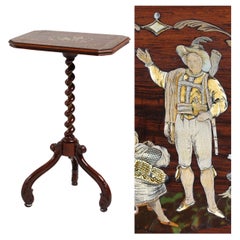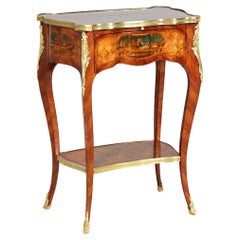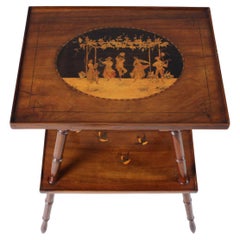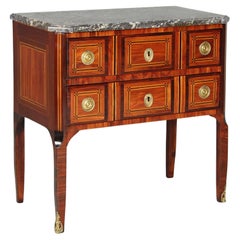Want more images or videos?
Request additional images or videos from the seller
1 of 10
Gardentable, Bistrotable with Pietra Dura Marble Top
Price:$3,937.42
$5,298.42List Price
About the Item
- Dimensions:Height: 28.35 in (72 cm)Diameter: 23.63 in (60 cm)
- Materials and Techniques:
- Place of Origin:
- Period:
- Date of Manufacture:20th Century
- Condition:The condition of this table is very good. Both the pietra dura top and the cast iron base are well preserved and have been carefully cleaned.
- Seller Location:Greven, DE
- Reference Number:1stDibs: LU5419245005112
About the Seller
4.9
Platinum Seller
Premium sellers with a 4.7+ rating and 24-hour response times
Established in 2014
1stDibs seller since 2020
196 sales on 1stDibs
Authenticity Guarantee
In the unlikely event there’s an issue with an item’s authenticity, contact us within 1 year for a full refund. DetailsMoney-Back Guarantee
If your item is not as described, is damaged in transit, or does not arrive, contact us within 7 days for a full refund. Details24-Hour Cancellation
You have a 24-hour grace period in which to reconsider your purchase, with no questions asked.Vetted Professional Sellers
Our world-class sellers must adhere to strict standards for service and quality, maintaining the integrity of our listings.Price-Match Guarantee
If you find that a seller listed the same item for a lower price elsewhere, we’ll match it.Trusted Global Delivery
Our best-in-class carrier network provides specialized shipping options worldwide, including custom delivery.You May Also Like
Pair of Directoire Style Bronze Tables with Pietra Dura Marble Top, French
Located in El Monte, CA
Outstanding pair of French Directoire style bronze round tables with semi precious gemstone (malachite, lapis lazuli, carnelian, agate, etc.) inlaid ...
Category
Late 20th Century Directoire End Tables
Materials
Multi-gemstone, Marble, Bronze
$9,000 / set
H 29 in Dm 22 in
Carved Giltwood Gueridon Side Table with Pietra Dura Top
Located in West Palm Beach, FL
Gueridon side table, having an antique, round pietra dura top, inlaid into a starburst motif. Its later, carved giltwood, table base, with a channeled apron, decorated with gadroonin...
Category
Mid-20th Century Italian Side Tables
Materials
Marble
Burmese Hand Carved Elephant Occasional Table Pietra Dura Specimen Marble Top
Located in West Sussex, Pulborough
We are delighted to offer for sale this lovely very rare 19th century Anglo-Indian / Burmese hand carved Elephant occasional table with Pietra Dura...
Category
Antique 19th Century Burmese Anglo-Indian Side Tables
Materials
Marble
$5,514
H 25.2 in Dm 27.17 in
1990s European Pietra Dura Mosaic Inlay White Marble Square Table Top
Located in Marbella, ES
Classical 1990s Spanish Pietra Dura mosaic inlay white marble square table top with intricate geometric and plant ornamentation using gemstones, in...
Category
Late 20th Century European Tables
Materials
Lapis Lazuli, Marble
$3,010
H 24.02 in W 24.02 in D 0.79 in
Pair of Pietra Dura Topped Circular Occasional Tables
Located in London, GB
This fine pair of 19th century occasional tables exhibit an exceptional example of the marble Pietra Dura technique. Developed in 16th century Florence, this highly skilled form of inlay uses pieces of cut marble, which are placed seamlessly together to create images. Each tabletop depicts a delicate bird perched on a branch. When placed side by side, the pair can be seen to create a narrative: One bird calls...
Category
Antique 19th Century Italian Side Tables
Materials
Marble
'Monarch', Vintage Butterfly Pietra Dura Table, English, Decorative, Marble
Located in Hele, Devon, GB
'Monarch' is a vintage butterfly pietra dura table. An English, heavy decorative marble piece by the renowned sculptural artist, Dominic Hurley.
A one-of-a-kind vintage work in ve...
Category
Late 20th Century British Side Tables
Materials
Marble
$8,898
H 30.32 in W 25.79 in D 26.19 in
'Cornucopia' Vintage Decorative Marble Table, English, Handmade, Pietra Dura
Located in Hele, Devon, GB
'Cornucopia' is a striking vintage decorative marble table. An English, handmade pietra dura by renowned sculptural artist Dominic Hurl...
Category
Late 20th Century British Side Tables
Materials
Marble
$17,177
H 30.71 in W 24.61 in D 25.79 in
Pietra Dura Mosaic Side Tables
Located in New York, NY
A pair of circa 1920s Italian pietra dura mosaic side tables with bronze bases.
Measurements:
Height: 26.5"
Diameter: 17"
Category
Vintage 1920s Italian Side Tables
Materials
Stone
Pair of Pietra Dura Game Tables
Located in Water Mill, NY
Pair of Pietra Dura octagonal game or side tables on faux bamboo ebonized stands-border design varies.
Category
20th Century Italian Game Tables
Rare Irish Armorial Pietra Dura Low Table with Seashells
By J. Darmanin & Sons
Located in New York, NY
The double serpentine form top made of various specimen marbles and inlaid with the armorial for the Baker family of County Tipperary, with motto "Hono Virtutis Satelles" surrounded by panels of sea shells. Signed. On a later ebonized base. Note some wear to painted surface of base.
The top was made by the best known marble working firm in 19th century Malta, J. Darmanin and Sons, who traded from about 1800-1880s and exhibited at several international exhibitions including the Great...
Category
Antique Mid-19th Century Maltese Coffee and Cocktail Tables
Materials
Marble
More From This Seller
View AllMid 19th Century Side Table with fantastic Marquetry
Located in Greven, DE
Side table with fine marquetry
France - Mid 19th century
Dimensions: H x W x D: 77 x 47 x 37 cm
Description:
Exceptional side table from the period around 1840, rarely found in th...
Category
Antique Mid-19th Century French Charles X Side Tables
Materials
Metal
Ladies Desk with Fine Marquetry, Attributed to Beurdeley, Paris, circa 1880
Located in Greven, DE
Finely marquetry ladies' desk, attributed to Alfred-Emmanuel-Louis Beurdeley
Paris
Rosewood and others
circa 1880
Dimensions: H x W x D: 74 x 55 x 36 cm
Description:
Rare and extr...
Category
Antique Late 19th Century French Louis XV Side Tables
Materials
Rosewood
Art Nouveau Etagere, Side Table, Fruitwood with Nice Inlays, France, Around 1910
Located in Greven, DE
Fine antique etagere
France (?)
Fruitwood
Art Nouveau around 1910
Dimensions: H x W x D: 69 x 42 x 31 cm
Description:
Dainty side table with two shelves.
Strongly slante...
Category
Early 20th Century French Art Nouveau Side Tables
Materials
Fruitwood
18th Century Transition Chest of Drawers with Marble Top, France, circa 1780
Located in Greven, DE
Small Chest of Drawers with Marble Top
France
Rosewood and others
Transition around 1780
Dimensions: H x W x D: 77 x 78 x 43 cm
Description:
Dainty French chest of drawers from th...
Category
Antique 1770s French Louis XVI Commodes and Chests of Drawers
Materials
Marble
19th Century Sidetable, France, c. 1890
Located in Greven, DE
Kleines Beistellmöbel mit Rolloverschluss und Schublade. Beistelltisch aus massivem Nussbaum mit dezenten Kontrasten aus Messing.
Empirestil, entstanden um 1890.
Maße: H x B x T: 7...
Category
Antique 1890s French Empire Revival Side Tables
Materials
Walnut
Louis XVI Side Table, Vide-Poche, Paris circa 1785, influenced by David Roentgen
Located in Greven, DE
Louis XVI side table - so-called Vide-Poche
Paris
Mahogany, brass, gilded bronze
around 1785
Dimensions: H x W x D: 72 x 50 x 33 cm
Description:
Two filigree lyres with embedded c...
Category
Antique Late 18th Century French Louis XVI Side Tables
Materials
Bronze



